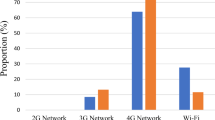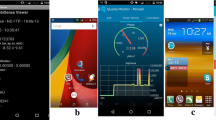Abstract
The aims of this study were to evaluate the weekly and annual cumulative radiofrequency-electromagnetic field (RF-EMF) exposure attributed to mobile phone (MP) use, and assess whether a novel app (Quanta Monitor™) could be employed in a small human sample to characterise the RF-EMF exposures associated with the use of MPs. Ten participants provided their two months’ daily objective data on their MP exposures (i.e. transmitted and received power densities) attributed to different modes of MP usage such as cellular calls, cellular data and Wi-Fi. The results demonstrated that total transmitted power density (cellular phone calls, data and Wi-Fi surfing) could be many orders of magnitude higher than that from the total received power density. Of the total transmitted power density, cellular data use contributed the largest portion. Our study showed that Quanta Monitor™ could be employed in prospective assessment of exposures to MPs in epidemiological studies.

Similar content being viewed by others
References
ICT Facts and Figures (2015) International Telecommunication Union (2016). Geneva. https://www.itu.int/en/ITU-D/Statistics/Documents/facts/ICTFactsFigures2015.pdf. Accessed 17 Aug 2017
Baan R, Grosse Y, Lauby-Secretan B et al (2011) Carcinogenicity of radiofrequency electromagnetic fields. Lancet Oncol 12:624–626
Cardis E, Armstrong BK, Bowman JD et al (2011) Risk of brain tumours in relation to estimated RF dose from mobile phones: results from five Interphone countries. Occup Environ Med 68(9):631–640
Grell K, Frederiksen K, Schüz J et al (2016) The intracranial distribution of gliomas in relation to exposure from mobile phones: analyses from the INTERPHONE study. Am J Epidemiol 184(11):818–828
Coureau G, Bouvier G, Lebailly P et al (2014) Mobile phone use and brain tumours in the CERENAT case-control study. Occup Environ Med 71(7):514–522
Frei P, Poulsen AH, Johansen C et al (2011) Use of mobile phones and risk of brain tumours: update of Danish cohort study. BMJ 343:d6387
Schüz J, Steding-Jessen M, Hansen S et al (2011) Long-term mobile phone use and the risk of vestibular schwannoma: a Danish nationwide cohort study. Am J Epidemiol 174(4):416–422
Benson VS, Pirie K, Schüz J et al (2013) Mobile phone use and risk of brain neoplasms and other cancers: prospective study. Int J Epidemiol 42(3):792–802
Inyang I, Benke G, Morrissey J et al (2009) How well do adolescents recall use of mobile telephones? Results of a validation study. BMC Med Res Methodol 9:36
Toledano MB, Auvinen A, Tettamanti G et al (2018) An international prospective cohort study of mobile phone users and health (COSMOS): factors affecting validity of self-reported mobile phone use. Int J Hyg Environ Health 221(1):1–8
Redmayne M, Smith E, Abramson MJ (2012) Patterns in wireless phone estimation data from a cross-sectional survey: what are the implications for epidemiology? BMJ Open 2(5):e000887
Vrijheid M, Cardis E, Armstrong BK et al (2006) Validation of short term recall of mobile phone use for the Interphone study. Occup Environ Med 63(4):237–243. https://doi.org/10.1136/oem.2004.019281
Inyang I, Benke G, Mckenzie R, Abramson M (2008) Comparison of measuring instruments for radiofrequency radiation from mobile telephones in epidemiological studies: Implications for exposure assessment. J Exposure Sci Environ Epidemiol 18(2):134–141
Bhatt CR, Redmayne M, Abramson MJ, Benke G (2016) Instruments to assess and measure personal and environmental radiofrequency-electromagnetic field exposures. Australas Phys Eng Sci Med 39:29–42
van Deventer E, van Rongen E, Saunders R (2011) WHO research agenda for radiofrequency fields. Bioelectromagnetics 32(5):417–421
Goedhart G, Vrijheid M, Wiart J et al (2015) Using software-modified smartphones to validate self-reported mobile phone use in young people: a pilot study. Bioelectromagnetics 36(7):538–543
Langer CE, de Llobet P, Dalmau A et al (2017) Patterns of cellular phone use among young people in 12 countries: Implications for RF exposure. Environ Int 107:65–74
The International Commission on Non-Ionizing Radiation Protection (1998) ICNIRP guidelines for limiting exposure to time-varying electric, magnetic and electromagnetic fields (up to 300 GHz). Health Phys 74(4):494–522
Gati A, Conil E, Wong M-F, Wiart J (2010) Duality between uplink local and downlink whole-body exposures in operating networks. IEEE Trans Electromagn Compat 52(4):829–836
Kuempel ED, Wheeler MW, Smith RJ et al (2009) Contributions of dust exposure and cigarette smoking to emphysema severity in coal miners in the United States. Am J Respir Crit Care Med 180(3):257–264
Ponnikas P (2015) Smart Phone Emission Measurement with Quanta Monitor
Ahonen M, Koppel T (2015) Minimising radiofrequency radiation exposure of smart phones and tablets-using an off-line reader instead of wireless browsing for mobile learning. In: Proceedings of Scientific Conference on Economics and Entrepreneurship Rīga, 14–17 October 2015
Popic JM, Bhatt CR, Salbu B, Skipperud L (2012) Outdoor 220 Rn, 222 Rn and terrestrial gamma radiation levels: investigation study in the thorium rich Fen Complex, Norway. J Environ Monit 14(1):193–201
Bergqvist U, Friedrich G, Hamnerius Y et al (2000) Mobile telecommunication base stations–exposure to electromagnetic fields. Report of a short term mission within COST-244bis
Wiart J, Hadjem A, Wong MF et al (2008) Analysis of RF exposure in the head tissues of children and adults. Phys Med Biol 53(13):3681–3695
Cardis E, Deltour I, Mann S et al (2008) Distribution of RF energy emitted by mobile phones in anatomical structures of the brain. Phys Med Biol 53(11):2771–2783
Funding
This study was funded by National Health and Medical Research Council (Grant No. APP1060205).
Author information
Authors and Affiliations
Corresponding author
Ethics declarations
Conflict of interest
All authors declare no conflict of interest. MJA holds small parcels of shares in Telstra which operates a cell telephone network in Australia.
Ethical approval
The study conduct was approved by the Monash University Human Research Ethics Committee (project number: CF14/3613 - 2014001902).
Rights and permissions
About this article
Cite this article
Bhatt, C.R., Redmayne, M., Abramson, M.J. et al. Estimating transmitted power density from mobile phone: an epidemiological pilot study with a software modified phone. Australas Phys Eng Sci Med 41, 985–991 (2018). https://doi.org/10.1007/s13246-018-0699-7
Received:
Accepted:
Published:
Issue Date:
DOI: https://doi.org/10.1007/s13246-018-0699-7




